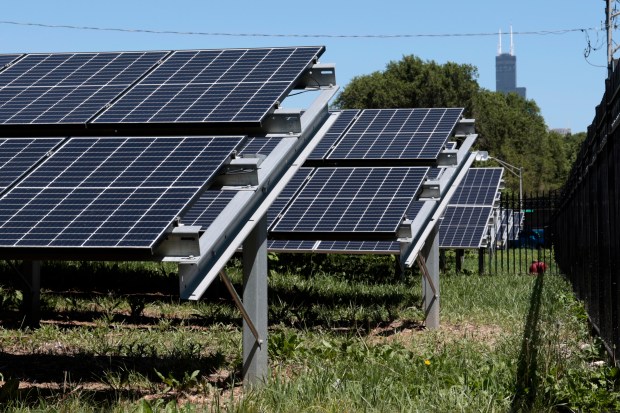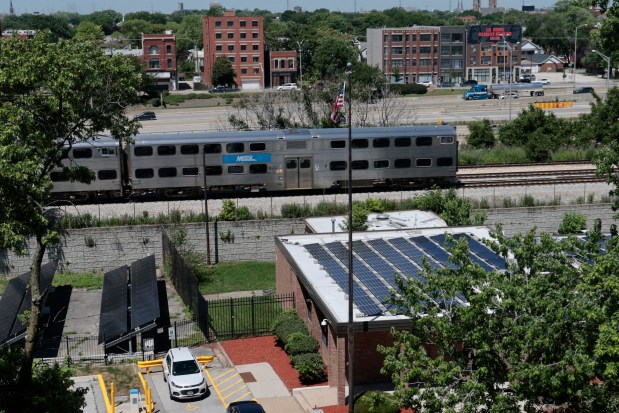Sri Raghavan Kothandaraman peered eagerly at the computer screens set up in a white ComEd truck parked in Bronzeville.
If all went well, the screens would show that ComEd’s long-awaited microgrid could successfully “island” — or disconnect from the main electric grid — and use its own power sources to keep electricity flowing to over 1,000 customers in the historic South Side neighborhood.
Kothandaraman, an engineer who had worked on the microgrid project for seven years, watched with his co-workers as the electricity generated within the microgrid rose.
At the same time, the power coming in from the larger grid fell — all the way to zero.
“I was ecstatic,” said Kothandaraman, manager for smart grid technology at ComEd. “I was literally jumping when I saw it go through successfully from grid-connect to island mode.”
The Bronzeville Community Microgrid, which went online last month — powered in part by solar panels at a midrise housing project — is the largest neighborhood microgrid in Illinois, and part of a broader effort to build a grid that’s cleaner, more reliable and more secure.
Microgrids — essentially minigrids that deliver electricity in defined areas — were the original grids in the United States and have been used extensively in remote parts of Alaska.
But the rise of clean energy and concerns about climate change, cyberattacks and extreme weather have helped fuel interest in a subset of microgrids: those, like the one in Bronzeville, that function as part of the main electric grid but can disconnect during larger power disruptions and operate on their own.
Such microgrids can help incorporate a growing amount of locally produced renewable energy — especially solar power — into the larger grid, according to Michael Pesin, deputy assistant secretary for grid systems at the U.S. Department of Energy’s Office of Electricity.
Microgrids also protect against outages, and they can save money by using electricity from the main grid at times when it costs less, and by exporting electricity to the main grid when it’s economical to do so, Pesin said. Microgrids increase efficiency by using locally produced power, which doesn’t have to travel long distances. They can even help support the main grid in times of stress.
“Microgrids play a vital role in modernizing (and) decentralizing energy infrastructure,” making it more resilient, sustainable and efficient, Pesin said.
The Department of Energy helped ComEd fund the $30 million Bronzeville microgrid with about $5 million in grants, including money to develop a microgrid “master controller” to run a cluster of microgrids.
Microgrid clusters are part of the Department of Energy’s plan for a future in which microgrids will not only have the ability to operate alone, as they do now, but to communicate and cooperate.
“Our vision is that microgrids should be the building blocks of the grid,” said Dan Ton, program manager of smart grid research and development at the Department of Energy’s Office of Electricity.
Hundreds of microgrids have been installed in the United States, many serving businesses, hospitals, universities or military bases. There are even residential developments built — or upgraded — to deliver electricity via microgrids.
But the Bronzeville project stands out as a “true urban microgrid” — a large project serving an existing big-city neighborhood, according to Mark Baranek, senior vice president of technical services at ComEd.
“To implement something that was completely within this type of an urban environment, and with an existing legacy type of system — and as we know, Bronzeville’s been around for a long time, so has ComEd in Chicago — this was really was unique,” Baranek said.
Among the challenges: Equipment, including a fiber communications network, had to be installed underground, in an area with railroads and CTA tracks.
Bruce Montgomery, a longtime member of ComEd’s Bronzeville community advisory council, said the microgrid, powered in part by solar panels installed at Dearborn Homes, “represents the future.”
“It’s important that communities like Bronzeville get to be early adopters, get a chance to be first rather than last, get a chance to be known for infrastructure, innovation and technology,” said Montgomery, founder and CEO of the Chicago-based Entrepreneur Success Program.

Historically the center of Black culture and commerce in Chicago, Bronzeville fostered artists such as Nat King Cole, Gwendolyn Brooks and Louis Armstrong and produced landmarks including Supreme Life Insurance, the first northern Black-owned insurance company, and Pilgrim Baptist Church, the birthplace of gospel music.
But the neighborhood has also suffered economically over the years, due to factors such as disinvestment and housing discrimination.
The microgrid serves a portion of Bronzeville bounded by 33rd Street to the north, 38th Street to the south, State Street to the west, and . Martin Luther King Jr. Drive to the east.
In addition to homes, the microgrid includes businesses and critical services such as Chicago Police Department headquarters, public works buildings, public transportation and health clinics.
ComEd said in a written statement that the Bronzeville microgrid is designed to island — and generate its own power — when “unforeseen major disturbances,” such as severe storms, affect the surrounding areas of the main electric grid.
“There still could be isolated outages within the microgrid due to small, localized disturbances, but the microgrid has automation and isolation capabilities that would significantly reduce the duration as well as the number of customers impacted,” the statement said.
Solar power for the microgrid comes from Dearborn Homes, where rooftop panels installed on 17 buildings — as well as two ground-mounted solar arrays — supply up to 750 kilowatts of electricity. That’s enough to meet 10% to 30% of the needs of the microgrid, depending on the time of year, according to Baranek.
There’s also 500 kilowatts of battery storage, and when the grid islands 4,800 kilowatts of natural-gas generation is available to ensure continuous power.
Dearborn Homes got its solar panels with the help of a Department of Energy grant tied to the Bronzeville microgrid project, according to the Chicago Housing Authority’s deputy chief of building operations, Ellen Sargent.
The CHA didn’t have to pay for the panels, which are owned by a solar company. And the housing authority buys the electricity that the panels produce at a rate that’s about 75% lower than normal.
“It’s been a win-win,” said Sargent.
The next step for the Bronzeville microgrid is to connect with the neighboring microgrid at the Illinois Institute of Technology, through microgrid clustering or networking.
Clustering of two or more independent microgrids hasn’t yet been accomplished, according to Illinois Institute of Technology Bodine Chair professor Mohammad Shahidehpour, who leads IIT’s work on the microgrid cluster.
“That project, once it’s fully in operation, represents the first cluster microgrid anywhere in the world,” Shahidehpour said at a ceremonial “switching on” of the Bronzeville microgrid in May.
Shahidepour said there have been COVID-related delays is obtaining hardware, but the wiring is done and he expects the project to be fully operational by late 2025 or early 2026.



